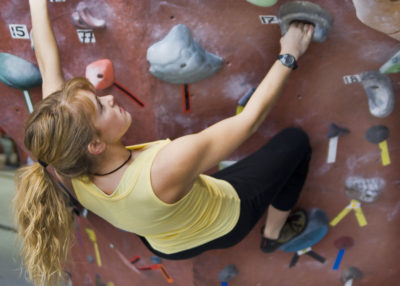There is no need to follow official regulations when bouldering for recreation. However, knowing and applying the rules around the start and finish takes guesswork out of the process. It provides objective feedback on how your performance stacks up, and besides, sometimes you just want to do things right.
For a proper start on a bouldering problem, the climber has hands and feet on the marked start holds, and no part of the body is in contact with the ground. In a valid finish, both hands are in contact with the finish hold. The climber must be in control of the position.
For any specific competition, refer to the official rules set out for that competition. The information provided here is for general interest: it’s only a quick primer, and is not advice.
Using the Starting Holds on a Bouldering Problem
A competition problem must be started from the marked start holds. If a short climber can’t reach the start holds, the IFSC (International Federation of Sport Climbing) confirms that jumping up to reach them is permitted. There is an example of this in the video below.
The IFSC states that a bouldering attempt is started when every part of the competitor’s body has left the ground (1).
The clock will be ticking, so don’t waste time on the start, but also don’t reach for any other hold until both hands and both feet are in contact with the marked starting holds. As soon as hands and feet are all in position, the climber is considered ‘established’ and can start the attempt by making a move to the next hold.
Where and how the hands and feet are actually positioned on the start holds is up to the climber.
How the starting holds are marked
In competition, the starting holds will be marked with “Start” or with tape of a different color than the rest of the holds on that problem. Some gyms will mark the start holds with a taped “V” that points towards the hold(s), or have a tape triangle next to the hold.
There can be one to four starting holds. A piece of tape that is used to mark a hold is called a flash. If there is only one start hold and it is marked with four flashes, the starting position would be an all-points start, where hands and feet are all placed on that one hold. There is an example of an all-points start in the video below.
When there is only one starting handhold, it will be marked with two pieces of tape instead of just one. Both hands must be placed on that one hold.
In rare instances, when a precise starting position is required, the holds may be labelled as right and left.
In the rare instance where no starting footholds are indicated, the feet can be placed on any of that problem’s footholds.
Sit starts
For sit starts, hands and feet must be on the marked start holds, while weight is supported by sitting on the ground. The attempt starts when you pull yourself off the ground.
How to Properly Finish a Bouldering Problem
The last hold on a bouldering problem will normally be taped with the same color tape as the starting holds. In recreational bouldering it will usually be marked by either a taped V, a taped half square, or there will be a full square of tape around it. In competition it may be marked Final or Stop, or simply with tape the same color as the starting holds.
If in doubt, ask which hold is the final before starting the attempt.
When is a bouldering attempt complete?
A bouldering attempt is complete when both hands are stable on the designated finish hold. The stability requirement basically means that jumping up and giving the final hold a quick slap before falling back down does not qualify. The final position must be controlled.
What is meant by a controlled finish?
Generally speaking, a hold is controlled when it has been used to bring about a stable position or deliberate movement. In competition, controlled will be defined in the regulations, and the judge will waive a hand or say “OK” to let the climber know when the final hold has been controlled. Both hands will have to be in direct contact with the hold until the judge signals that the finish is acceptable.
A controlled finish counts even if only the fingertips are touching the finish hold.
Sometimes there is no final hold, and it is a taped section of wall that must be touched and controlled. Problems like this require topping out, and the attempt is complete when the climber is standing on top of the boulder.
In competition, the finish must be achieved within the amount of time specified for that problem. For example, if the time limit is four minutes, the climber can make any number of attempts on that specific problem within that four minutes.
If you achieve a successful finish on the first try, you have ‘flashed’ that problem.
Climbing back down from a successful finish can be done on any available holds. If you are new to the sport, check out my article on how to land safely here.
In a recreational bouldering session, you decide for yourself if your finish was satisfactory. If you decide an attempt was a fail, it’s good practice to redo the problem. A failed problem is an opportunity to work out better beta.
Some common causes of failed attempts:
- The final hold is only briefly touched, as the climber is falling
- Only one hand touches the final hold
- Any part of the body, at any time during the climb, touches the ground
- The attempt goes over the allotted time restriction for that problem
- A spotter, or anyone else, touches the climber during the attempt
Watch a Quick Video on Bouldering Competition Rules
This video by the Ontario Climbing Federation provides an excellent overview of common competition rules. The video demonstrates correct and incorrect starts and finishes, and is well worth watching.

